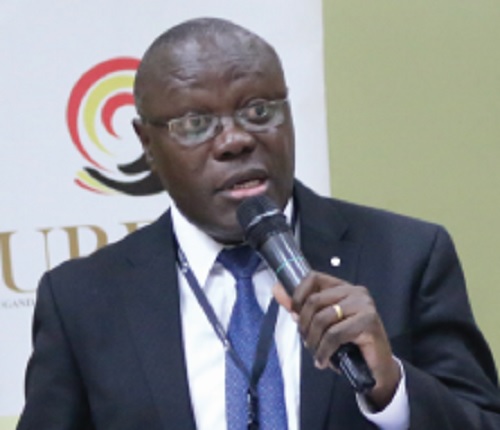
Financial expert concerned with 70% investment in government securities
Kampala, Uganda | JULIUS BUSINGE | Uganda’s pension sector is continuing to grow with the latest figures indicating that assets – a major indicator of growth – have increased from Shs5.2trillion in 2014 to Shs10.04trillion in 2017.
This represents 93% growth. This is lower than Tanzania’s Shs20 trillion and Kenya’s Shs37.8 trillion pension sectors.
The Uganda Retirement Benefits Regulatory Authority (URBRA) report for 2017 released on July 18 at the Imperial Royale Hotel in Kampala shows that out of the total assets recorded, the National Social Security Fund has about Shs9trillion.
The rest is owned by the other small saving schemes. The increased assets means employees are saving more with pension schemes, and that more money is available for borrowing through commercial banks to among other things power the economy and create jobs.
Releasing the report, the Acting Chief Executive Officer, Martin Nsubuga, said the compound asset growth rate for the last four years was 15.46% driven by contributions, investment earnings from government bonds, deposits, and listed equity.
“This was a commendable performance given the declining interest rate environment and depressed equity market conditions witnessed in 2017,” Nsubuga said adding, “At sector level there is no distress.”
The country’s interest rates have fallen from as a high as 20.3% per annum in December last year to around 17% at the moment.
Nsubuga added that amidst the growth, they remain cautious given that while some investments saw positive returns, they lost value on the original capital at the same time. He said the sector’s return on investment increased from 11.6% in 2016 to 14% in 2017.
This, however, is lower than the 18.2% return on investment recorded in 2015 and 16% in 2014. The new report comes at the time the government is considering amending the 1985 NSSF Act to incorporate issues that were raised earlier by different players during attempts to liberalise the sector.
Andrew Kasirye, the URBRA’s board chairman, said the sector’s growth reflects the board’s efforts for building the foundation for effective discharge of the authority’s functions.
To date, the sector is comprised of two mandatory, eight umbrella (with 104 participating employers) and 53 segregated schemes.
The authority has so far licensed nine administrators, seven fund managers, five custodians, four corporate trustees and 415 individual trustees to ensure segregation of duties with the goal of mitigating operational and governance risks.
Kasirye added that professionalism and strategic approach has built confidence in the regulator, resulting into a number of positive attributes – among them is increased asset growth. “We are also vigilant in implementing our supervisory framework.
I therefore reiterate URBRA’s oversight responsibility over all retirement benefits schemes and service providers, and I reassure the public that their savings are under well-managed schemes,” Kasirye said.
Investment areas
According to the report, government securities takes the largest share of total investment by asset class (71.7%) followed by quoted equities (15.4%), property (5.3%), fixed deposits (2.6%), unquoted equities (2.2%), corporate bonds (1.3%) and other investments (1.4%).
However, some market analysts have raised concerns on this investment cluster. Joseph Lutwama, the policy, legal and regulatory specialist at Financial Sector Deepening Uganda (FSDU) was concerned about the 70% of funds being invested in government securities yet the country’s debt servicing costs are close to 30% of the national budget.
He said this would pose a big risk in the event that government finds it difficult to meet its debt obligations and that the earnings would also drop in the event that interest rates on bonds decline. However, Nsubuga said in a bid to avoid the risk of poor stewardship, they issued targeted information and guidance to the various parts of the regulated community, spanning all areas of the business.
Beyond Uganda
The sector asset to GDP ratio was quoted at 14% for Uganda, 10% in the case of Kenya and 11% for Tanzania. Workers covered were 20% for Kenya compared with 14% and 10% for Uganda and Tanzania, respectively. The number of mandatory schemes for Uganda currently stands at two compared with one in Kenya and seven in Tanzania.
Similarly, occupational schemes stands at 1,302 in Kenya, 61 in Uganda and seven in Tanzania. However, Tanzania has the highest number of informal sector schemes (05) followed up with Uganda and Kenya, with two and one, respectively.
Going ahead, Nusbuga said they envision a well regulated and performing retired benefits sector for Uganda through the current regulatory framework and technical competence of the regulator and other sector players. He said the regulator has also come up with a training programme aimed at improving standards of scheme governance, administration and compliance with the URBRA Act
 The Independent Uganda: You get the Truth we Pay the Price
The Independent Uganda: You get the Truth we Pay the Price


